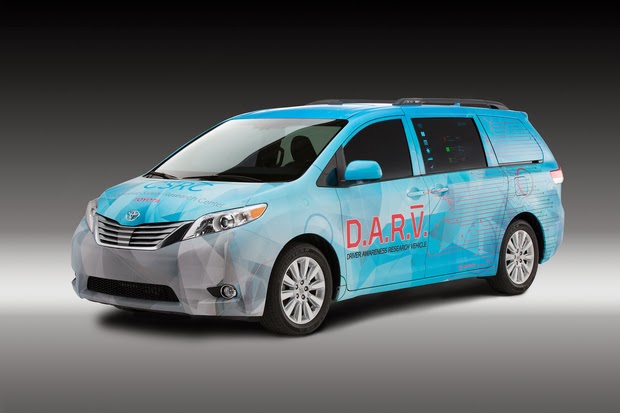What can automakers do to improve highway safety? The other day I wrote about the coming age of autonomous vehicles and how they might both reduce traffic congestion and reduce traffic accidents. Today, Toyota has announced some in-car-gizmos meant to increase Driver Awareness, and therefore reduce traffic accidents.
Having been party to a couple dozen traffic accidents in my life (I wasn’t the driver in most cases, BTW) one lesson I take is that in every traffic accident one or more participants were simply not paying attention. I believe strongly that if drivers simply practiced Awareness While Driving, the roads would be safer. Motorcycle safety training is all about inoculating motorcyclists-to-be with that idea. But, in practice, most drivers aren’t paying attention well enough.
“At Toyota, our focus is not only on protecting people in case of an accident, but also on preventing that accident from happening in the first place,” said Chuck Gulash, Director of Toyota’s Collaborative Safety Research Center (CSRC). “While the auto industry will never eliminate every potential driver distraction, we can develop new ways to keep driver attention and awareness where it needs to be – on the road ahead.”
Toyota’s Driver Awareness Research Vehicle (DAR-V) is a test-bed for working with three specific technologies meant to help drivers.
Reducing Potential Distractions Before Driving: The idea is that before the driver gets into their car, to show them an information screen with data such as fuel levels, weather, or traffic conditions. The goal is to give drivers more mental bandwidth while driving by being pre-informed of critical information. The research partner is Microsoft, so of course they’re looking at gesture control with the Kinect stuff.
“Cars have become an interaction of multiple screens. Initially, there was the windscreen,
and rear window and the rear and side-view mirrors,” said Gulash. “We
now have multiple gauge clusters, large information screens and heads-up
displays all feeding us information and competing for our attention.”
“We need to start thinking of the car and the driver as teammates,
sharing the common goal of saving lives,” said Gulash. “The best
teammates learn from each other. They watch, listen and remember. They
adapt. They communicate. And they assist, as needed. In doing so,
over time, a foundation of trust is built. Together, the teammates are
building a common situational awareness of their driving environment.”
Human Factors of Voice Command: Researchers found that the mental demands on drivers while using voice
command were actually lower than expected, potentially because drivers
compensate by slowing down, changing lanes less frequently or increasing
the distance to other vehicles. However, in a number of the voice
interactions studied, the amount of time drivers took their eyes off the
road during voice command tasks was greater than expected. The
situation is often more pronounced among older drivers, some of whom
were found to physically orient their bodies towards the voice command
system’s graphical interface when engaging with it.
Stanford Autonomous Driving Human Factors: Toyota and Stanford have worked together to build a driving simulator to test shifting between fully autonomous driving, fully human-controlled driving, and a mix of those. The system combines EEG sensors to track brain activity, skin sensors
to measure emotional arousal and eye-tracking headgear to follow
directional glances. The system can perfectly align what’s happening
inside the car, what’s happening outside the car and what‘s happening
inside the driver’s brain.
The project will help to understand how a driver responds
to a sudden “takeover now!” alert compared to less aggressive commands
or explanations. Other issues include studies of how driver abilities
are affected by prolonged periods in fully automated mode, including
potential reduction in reaction times or situational awareness.
“These are questions that need to be answered”, Gulash concluded, “not
only to help build a product. But also, to build a foundation of
understanding and guidelines for how we proceed with further research
into the human factors of automated vehicles.”
- Highway design could decrease death and injury risk, if “we” chose smarter designs - March 28, 2015
- GM really did trademark “range anxiety”, only later to abandon that mark - March 25, 2015
- US Government releases new regulations on hydraulic fracturing, that some call “toothless” - March 20, 2015
- Tesla Motors magic pill to solve range anxiety doesn’t quite instill range confidence - March 19, 2015
- Update on Galena IL oil train – 21 cars involved, which were the supposedly safer CP1232 design - March 7, 2015
- Another oil bomb train – why are they shipping crude oil by train? – Symptoms of fossil fuel addiction - March 6, 2015
- Chevron relinquishes fracking in Romania, as part of broader pull-out from Eastern European fracking operations - February 22, 2015
- Answer anti- electric car articles with truth and pride – truth outshines all distortions - February 19, 2015
- Apple taking big risk on developing a car? Please, Apple, don’t go there! - February 16, 2015
- Toyota, Nissan, Honda working on Japanese fuel cell infrastructure for Japanese government - February 12, 2015















